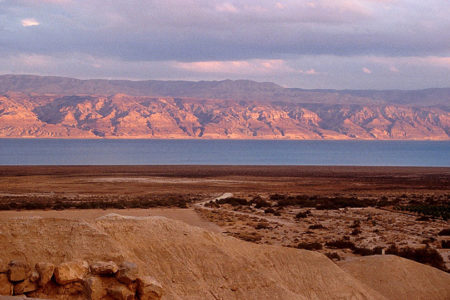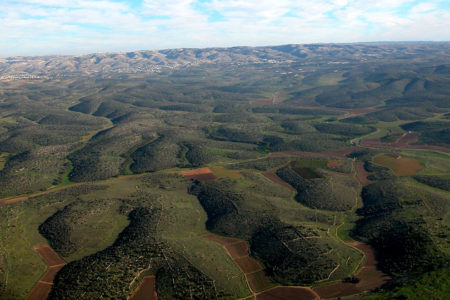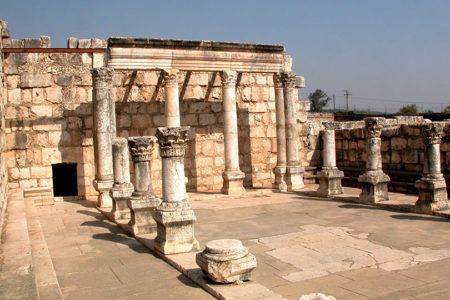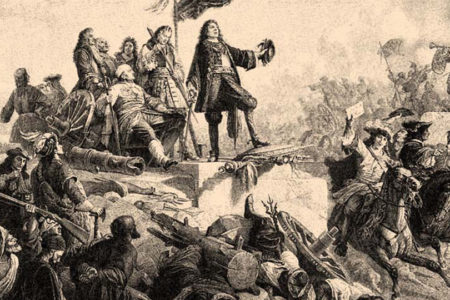Judah’s Inheritance: The Dead Sea, En Gedi, Qumran, Hebron
The Holy Land is, in reality, God’s land.
He Himself is the Creator and Owner of every land on Earth, but He specifically identifies Israel as “My land” (2 Chr. 7:20; Jer. 2:7; Joel 3:2). God allowed the Canaanites to occupy that land after the flood of Noah’s day. In due course, He punished them by transferring ownership of His land to His own chosen nation, the people of Israel. The Lord told them, “I delivered you out of the hand of…all who oppressed you, and drove them out before you and gave you their land” (Jud. 6:9).
After Joshua led the tribes of Israel to fight for the land, as God had instructed, the Israelites received title to it. God transferred possession to the tribes, as recorded in Joshua 13—21, which lists the cities and lands allotted to each tribe and gives detailed descriptions of individual cities. Joshua 15 describes the territory assigned to Judah, with its key cities located between the Mediterranean and Dead Seas. Hebron, an important Jewish city, is in Palestinian hands today. But the Dead Sea, En Gedi, and Qumran belong to Israel.
The Dead Sea
Within the fault line that extends 4,000 miles from Turkey to Africa lies the world’s most unusual body of water. The Bible calls it the Salt Sea, the Sea of the Arabah, and the Eastern Sea. It is popularly known as the Dead Sea because it is 30 percent minerals. Compared with most oceans, which have a mineral concentration of only 3 percent, it is little wonder that nothing lives in its waters. The cause of such dense salinity is simple: there is no outlet at the sea’s south end. Evaporation removes the water but leaves the minerals. Tourists from around the world flock to hotels nestled around the healing waters. Anyone can float without fear, since it is impossible to sink!
The Dead Sea, forming a border between Israel and Jordan, measures about 50 miles long and 10 miles wide. Its precise size is difficult to determine, since it is slowly decreasing. Both Israel and Jordan tap the Jordan River for irrigation, leaving little water to drain south into the sea. Tourists can drive past a mark British geologists made in 1917 noting the height of the Dead Sea on the rock face—50 feet above the current roadway! Proposals to infuse water into the sea have included constructing a canal from the Mediterranean Sea or Red Sea.1
A small peninsula called the Lisan (“tongue”) divides the northern two-thirds of the Dead Sea from the southern one-third. The sea’s surface is the lowest level on Earth—1,300 feet below sea level. Its bottom lies another 1,300 feet lower, and the bedrock underneath the sedimentary deposits lies about 24,000 feet below sea level.2 In comparison, Death Valley in California, the lowest point in the United States, is only 282 feet below sea level.
The ancient world valued the Dead Sea’s salt and the hardened petroleum called bitumen used by the Egyptians for embalming. Josephus and other ancient writers referred to it as the Lake of Asphalt. Today both Israel and Jordan extract minerals from the water and produce cosmetics ranging from hand cream to healing mud.
The Salt Sea is mentioned only in passing in the account of Abram’s battle with foreign kings and in descriptions of geographical borders (Gen. 14:3; Num. 34:3; Josh. 12:3). However, the prophet Ezekiel gave a unique prophecy about the sea:
There will be a very great multitude of fish, because these waters go there; for they will be healed, and everything will live wherever the river goes. It shall be that fishermen will stand by it from En Gedi to En Eglaim; they will be places for spreading their nets. Their fish will be of the same kinds as the fish of the Great Sea, exceedingly many (Ezek. 47:9–10).
In the Millennial Kingdom, God will cause a freshwater river to flow down from Jerusalem, turning the Dead Sea into a “living sea.”
En Gedi
Nestled alongside the western shore of the Dead Sea at the base of 2,000-foot cliffs lies the “Spring of the Wild Goats,” which in Hebrew is En Gedi. These wild goats, known as ibex, still grace the steep cliffs in the En Gedi Nature Reserve. The spring feeds a waterfall that splashes to a pool 600 feet below.
Earliest history finds Canaanites living at this strategic location alongside the Dead Sea and worshiping at a temple on a nearby mountain. After the conquest of the land, Israelites settled here, but not in great numbers. Perhaps this is why David chose to hide here from Saul (1 Sam. 24). Such a remote area would be a natural hiding place, desolate yet full of natural caves and close to the spring water. Some of David’s psalms feature images from the area around En Gedi. David wrote Psalm 57 “when he fled from Saul into the cave.” (See also Psalm 142.) After fleeing from Saul, David penned words inspired by the animals that surrounded him at En Gedi: “He makes my feet like the feet of deer [hinds’ feet], and sets me on my high places” (Ps. 18:33).
The postexilic community of En Gedi grew and served as an administrative center during the Hasmonean dynasty (100 B.C.). Sadly, during the First Jewish Revolt (A.D. 66–70), Jewish Zealots defending nearby Masada wiped out the entire population of 700 men, women, and children.3 Settlement continued in the next centuries, with a prosperous Jewish community rebuilding an older synagogue with unique mosaic floors that can be seen today. Its importance ended during the early Muslim period, and 1,300 years later it was incorporated into the new State of Israel in 1948.
Today En Gedi is an Israeli nature reserve and hosts visitors from around the world. The hike to the refreshing falls always thrills those who brave the climb. Standing in stark contrast to the desert heat that surrounds it, the spring continually pours out water that enriches the tired traveler and turns the bare surroundings lush green. All of God’s people can echo David’s experience of God’s protection in one of En Gedi’s caves: “I cried out to You, O Lᴏʀᴅ: I said, ‘You are my refuge, my portion in the land of the living’” (Ps. 142:5).
Qumran
The importance of Qumran surfaced in 1947. A Bedouin shepherd tossed a stone inside a cave on the northwest shore of the Dead Sea, hoping to locate his wandering goat. Instead of hitting the animal, his rock smashed a clay jar that contained leather scrolls. Soon an antiquities dealer in Bethlehem acquired the scrolls, which eventually were purchased by the State of Israel. Since then, hundreds of caves in the area have been explored, and some have yielded manuscripts now known as the Dead Sea Scrolls. The Shrine of the Book, located at the Israeli Museum in Jerusalem, displays many finds from Qumran.
The Dead Sea Scrolls (they contain about 200 copies of the Jewish Scriptures, as well as other writings) were copied between 250 B.C. and A.D. 68, when they were hidden from the invading Roman army that destroyed the community. Although scholars disagree about many details, they affirm that people known as the Essenes placed the scrolls in the caves. These strict Jews abhorred the unholy priesthood in Jerusalem and lived separately, in their own community. Their writings reveal that they anticipated the end of the world, culminating in a battle between the sons of light and the sons of darkness.
Visitors to Qumran can enjoy a multimedia presentation and follow a trail through the foundations of the community’s buildings. Hikers can still follow the path of the Essenes to a few caves—but no scrolls remain. It may be more than a coincidence that the scrolls of ancient Israel were discovered in the very year that modern Israel was founded.
Hebron
About 20 miles south of Jerusalem lies Hebron, the world’s oldest Jewish community. Arabs call it El Khalil, meaning “The Friend,” which recalls God’s affection for “Abraham My friend” (Isa. 41:8). After his separation from Lot, the patriarch made Hebron his home (Gen. 13:18). It was here that Abraham laid claim to the Promised Land that God had solemnly sworn to give him.
After negotiations with a Canaanite, Abraham agreed to buy the field and cave of Machpelah, which then “were deeded to Abraham as a possession” (23:17–18). He buried his wife, Sarah, in the cave, which later became his own tomb as well as that of Isaac; Rebekah, his wife; Jacob; and Leah, Jacob’s wife (49:29–33).
After the Exodus from Egypt, 12 Israelite spies visited Hebron and brought back a great cluster of grapes (Num. 13:22–23). After Israel conquered the land, the fields and villages of Hebron were granted to one of those spies, Caleb, a great man of faith (Josh. 14:10–15). Hebron itself was given to “the children of Aaron the priest” and was one of six cities of refuge (21:13). Eventually it served as a capital city, for here David was first crowned king of Judah and, seven years later, king of both Israel and Judah (2 Sam. 2:1–4; 5:1–5). Later David moved his capital to Jerusalem.
During the first century, Herod the Great constructed a large complex above the Cave of Machpelah to honor those buried beneath. This Tomb of the Patriarchs features large hewn stones similar to those used when Herod enlarged the Temple Mount in Jerusalem. During the Byzantine Empire the tomb included a church that was converted into a mosque by the invading Muslims in the seventh century. Inside the structure, six monuments have stood for a thousand years—memorials for the three patriarchs and their wives. Jews share the complex with Muslims, with both groups expressing devotion to common ancestors.
From 638 to 1880 Hebron was one of “the four ‘Holy Cities’ of Judaism, in which there was continuous Jewish settlement from biblical times,” wrote historian Martin Gilbert.4 The others were Safed and Tiberias, in the Galilee, and Jerusalem.5
Hebron’s Jewish population continued until the tragic Arab Revolt of 1929, when more than 1,000 Arabs went on the rampage and killed every Jew they could get their hands on. Those they could not kill they tortured and maimed. In Hebron they murdered 23 in one house alone.6 Only after the Six-Day War (1967) did Jewish people return to Hebron. They now live in two small communities: the Old City, with about 500 Jews; and a settlement of about 6,000 that takes the Canaanite name, Kiryat Arba (Josh. 14:15).
Under Oslo II in 1995, Hebron was transferred to the Palestinian Authority.
ENDNOTES
- Michael Beyth, “The Red Sea and the Mediterranean Dead Sea Canals Project,” Israel Ministry of Foreign Affairs, August 10, 2002 <www.mfa.gov.il/MFA/MFAArchive/2000_2009/2002/8/The%20Red%20Sea%20and%20the%20Mediterranean%20Dead%20Sea%20canals>.
- Barry J. Beitzel, The Moody Atlas of Bible Lands (Chicago: Moody Press, 1985), 37.
- Josephus, The Jewish War7.2.
- Martin Gilbert, The Routledge Atlas of the Arab-Israeli Conflict, 7th ed. (London: Routledge, 2002), 2.
- Ibid.
- Ibid., 13.






